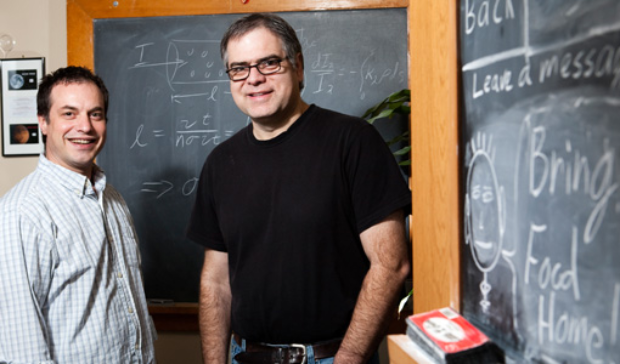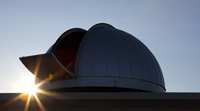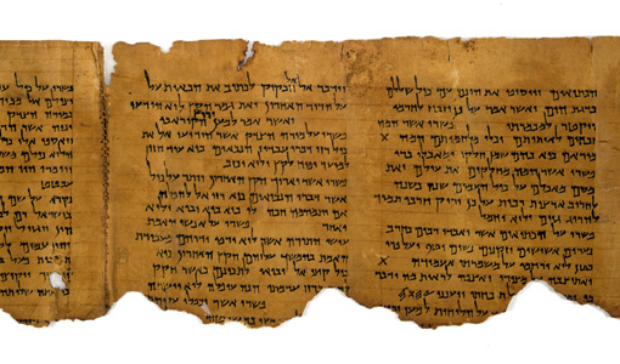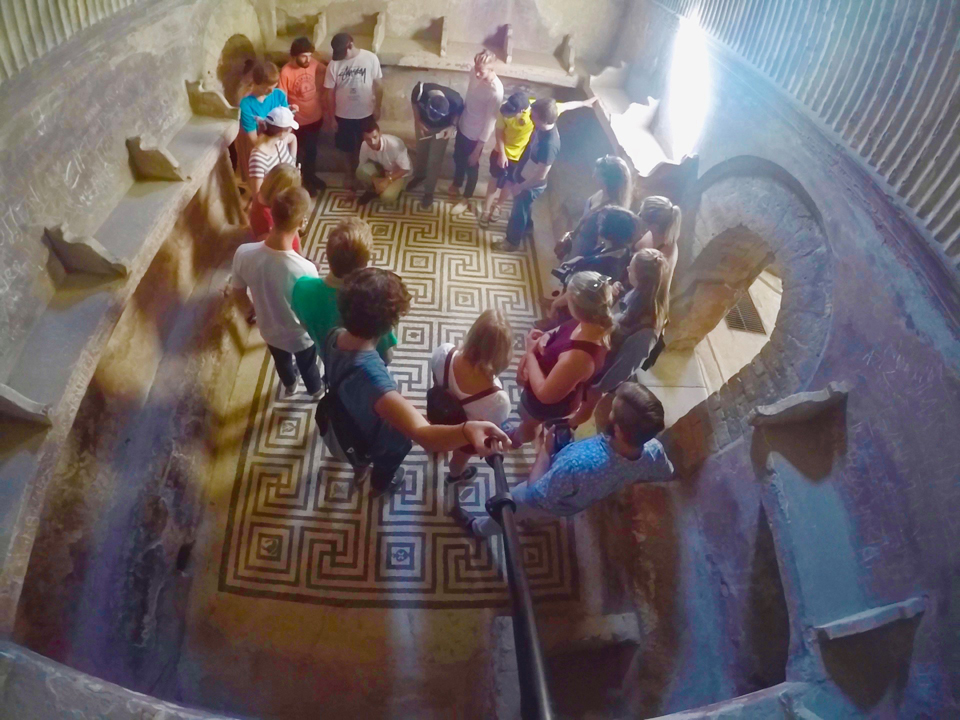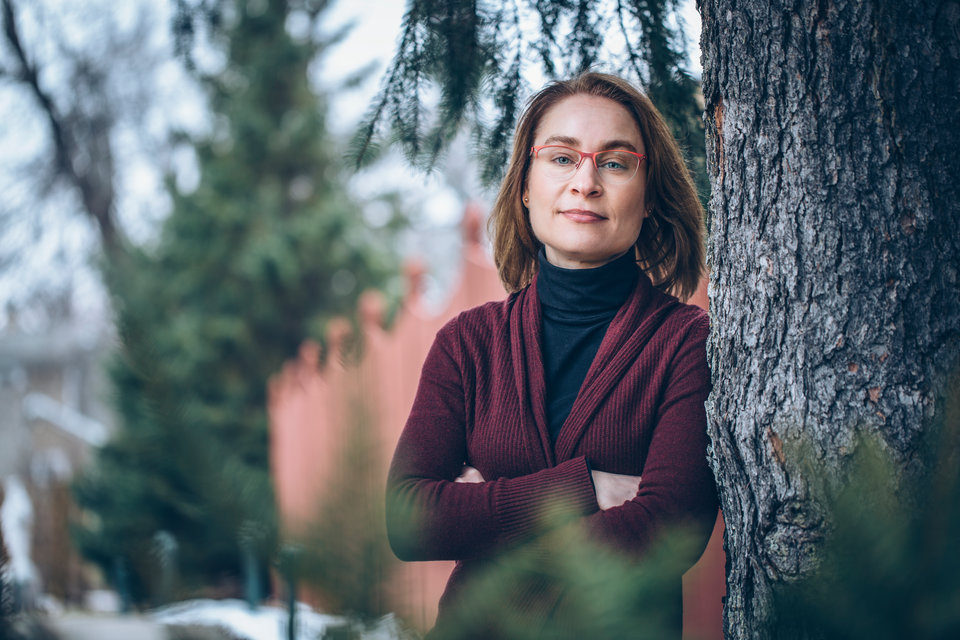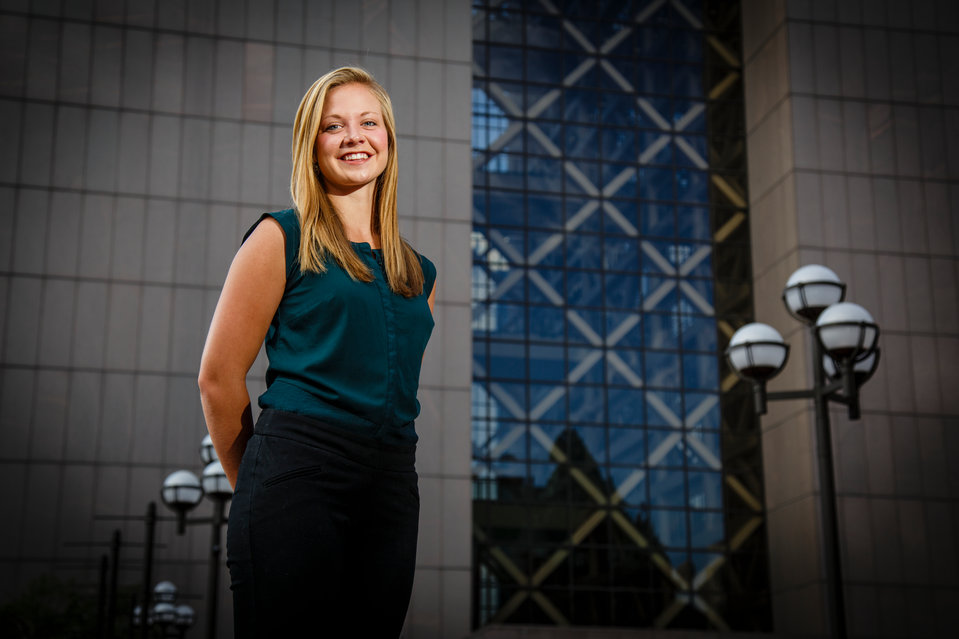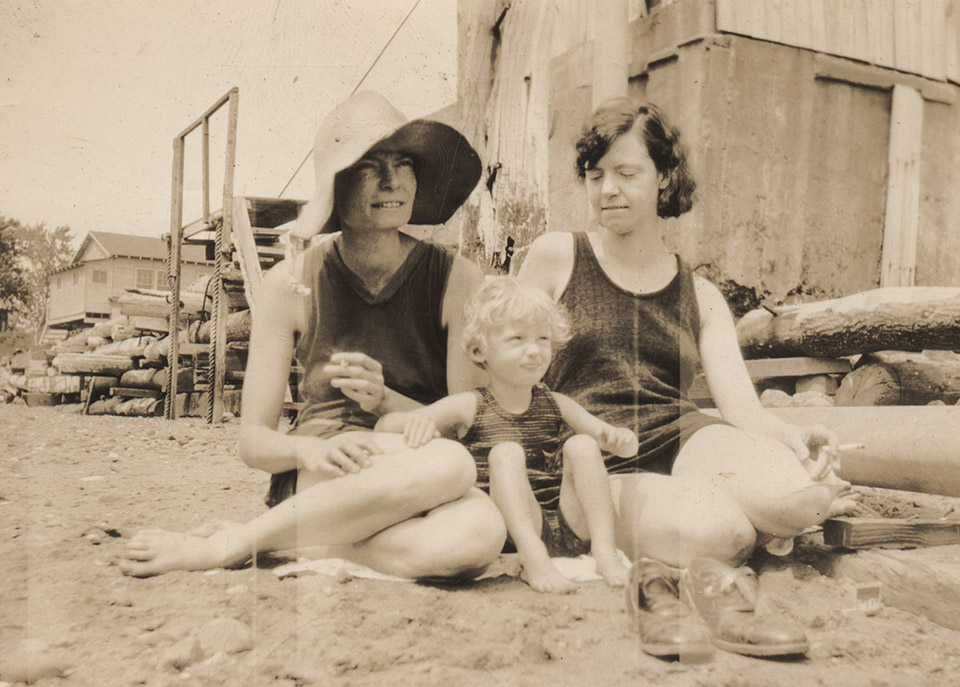Astronomy is one of those topics that naturally generates enthusiasm. Contemplating the sheer scale of the universe and our place in it is a truly humbling and awe-inspiring experience. The teacher in me [Gerry] loves to use that moment when a student or a visitor is rapt, that moment when they are looking into space saying, "Wow! What is that thing?" I tell them not only what the object is but how we, mankind, tiny creatures stuck to a speck, came to understand the nature of space.
Visitors and students always are fascinated to know, for example, that the colorful fuzzy object in the telescope represents the ultimate fate of our sun: that one day, our own sun will run out of fuel and put on a similarly amazing display as it dies. They then are equally fascinated to learn about the long history of great thinkers and their great thoughts from which, over many years of massive effort, our current view of the universe slowly emerged.
It is through experiences such as these that we can explain what the enterprise of science is all about and how it operates through us to reveal the inner workings of nature.
No more lugging telescopes around campus Inspired by the need to provide hands-on observing experiences for students in the astronomy course, St. Thomas' new robotic observatory is intended to bring the heavens not only to UST students, but to other students, educators and the public.
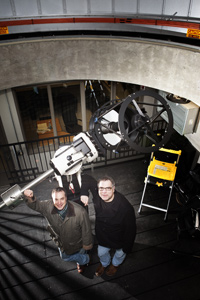 It all started in the fall of 1995 when comet Hale-Bopp made a grand appearance in the night sky. It was bright enough to be seen with the naked eye and watching it became an American pastime. St. Thomas astronomy instructors Jim Rada, Geoff Lawrence and Paul Lane, recognizing the wonderful teaching opportunity, took full advantage of student interest. On many clear nights, they could be seen lugging telescopes and hot coffee around campus in search of the perfect observing site. When Hale-Bopp departed our skies 18 months later, it was clear that we needed a permanent observing location better than the top of Dowling Hall.
It all started in the fall of 1995 when comet Hale-Bopp made a grand appearance in the night sky. It was bright enough to be seen with the naked eye and watching it became an American pastime. St. Thomas astronomy instructors Jim Rada, Geoff Lawrence and Paul Lane, recognizing the wonderful teaching opportunity, took full advantage of student interest. On many clear nights, they could be seen lugging telescopes and hot coffee around campus in search of the perfect observing site. When Hale-Bopp departed our skies 18 months later, it was clear that we needed a permanent observing location better than the top of Dowling Hall.
The search for a suitable location went into high gear when Dr. Ed and Dr. Pat Johnston, my parents [Marty], donated some astronomy equipment to the school, including a high-quality 10-inch telescope. Having that instrument motivated us to find a dedicated place on campus to house it. When the Anderson Parking Facility was proposed, we jumped at the opportunity to reserve one or two parking stalls on the top level where a small shed could house the telescope. That simple idea grew, and today we have a first-rate observatory housing a 17-inch robotic telescope. With the encouragement and support of the university, our vision expanded beyond simply hosting viewing nights for astronomy students into a remarkable facility with the ability to truly have an impact on many people.
The importance of scientific literacy The primary mission of the UST Physics Department Observatory is education. Scientific literacy is critically important not only for future scientists and engineers but for everyone. We are all stewards of this planet. As such, we are obligated to future generations to understand the consequences of our actions and make rational, informed decisions. A variety of issues in which science plays a central role, such as climate change, medical research and sustainable energy, are often under our collective consideration, and it is impossible to fully engage in the public discourse in a civil manner without a firm understanding of rudimentary scientific principles.
Additionally, the United States continues to fall behind other countries in basic math and science competency. We stand to lose our position as a world leader in basic research and technological development if basic science and math skills are not valued in our society. As scientists and educators, we have a responsibility to raise the level of scientific literacy. The observatory is a perfect platform to generate interest and excitement about science while simultaneously providing a rewarding educational experience.
'How far can this thing see?' One of the first questions asked by someone looking through a telescope for the first time is: "How far can this thing see?" They are, quite naturally, seeking a sense of the power of the telescope. A better question, perhaps, is: "What's the dimmest object that this thing can see?" because the true power of a telescope lies in the amount of light it can gather. The light-gathering power of a telescope is measured by the size of its primary mirror or lens. As of this writing, the largest telescope in the world, with a 10.4-meter primary mirror, is the Gran Telescopio Canarias located in the Canary Islands. It is reserved exclusively for cutting-edge astronomical research. Our telescope, a PlaneWave CDK17, sports a 17-inch primary mirror, putting it among the largest amateur instruments and at the small end of those used for research. A large catalog of objects lies within easy reach of a 17-inch telescope, including planetary targets such as Jupiter and its moons, Saturn and its rings, Mars, Venus and Neptune, as well as "deep sky" objects such as planetary nebula (sun-like stars that have ended their lives in a spectacular display), stellar nurseries (giant clouds of gas where new stars are being born) and galaxies beyond the Milky Way.
It is not uncommon for universities to host an observatory. For example, the University of Minnesota Astronomy Department operates two research facilities, a 30-inch telescope near Marine on St. Croix, Minn., and a 60-inch telescope on top of Mount Lemmon in Arizona used almost exclusively by astronomy graduate students. Macalester College and St. Catherine University host 16-inch telescopes, and St. John's University hosts a collection of smaller telescopes, the largest being a 12-inch instrument – all used primarily for regular public observing. The UST Physics Department Observatory is unique to the area in a couple of ways. First, it is fully robotic, meaning that every aspect of its operation is under computer control and ultimately will have capabilities for remote- and unattended-operation. Second, through a variety of programs, it will be made available to a large audience including students, the public and educators.
Although our facility clearly can't compare in scale to the Gran Telescopio Canarias, it intentionally is designed to emulate just such a professional observatory. The telescope is attached to a computer-controlled robotic mount (the AstroPhysics el Capitan) that aims it at the desired astronomical target. An eyepiece can be used for viewing, but most of the time a digital camera will send the images from the telescope to a computer in an adjacent climate-controlled room with large windows looking into the dome where the telescope is installed. The telescope itself must remain at the outside air temperature to maintain the highest possible image quality, however, the observers do not need to remain outside. They can relax in the comfort of the room, control the telescope, take images, and view the wonders of the universe on a 36-inch, high-definition monitor.
Because the facility is under computer control, it ultimately will be possible to operate it remotely over the Internet. Remote operation opens access to a large audience of potential observers and allows a wide variety of observational projects. In addition to live remote access, plans are under way to implement the capability for unattended operation. In this scheme, a potential observer writes and submits an observing plan to the observatory. The telescope then wakes up in the middle of the night, performs the observation, and makes the result available for the observer, who can be at home sound asleep.
The positive impact on students The observatory will be integrated into the St. Thomas physics curriculum in several ways. Approximately 200 students a year take Physics 104, an introductory astronomy course with an associated lab, aimed primarily at non-science majors. This course is one of a small number of opportunities that we have to contact non-science students. Our overarching goal is to have them leave the course with a positive attitude toward science and with a solid understanding of the fundamental principles of scientific investigation. Hands-on experience is critical. Using the observatory in the lab, they can gather their own data and see firsthand how it is used to investigate the natural world.
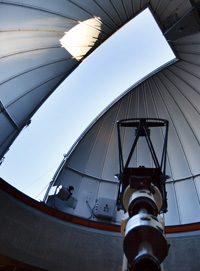 Advanced physics students also can use the observatory to learn about astronomical data analysis, take part in long-term observational projects, or design and implement their own observing programs and research projects. Because the observatory is robotic and will have the capability of operating unattended, students can plan and implement long-term observational projects without spending multiple long nights at the telescope.
Advanced physics students also can use the observatory to learn about astronomical data analysis, take part in long-term observational projects, or design and implement their own observing programs and research projects. Because the observatory is robotic and will have the capability of operating unattended, students can plan and implement long-term observational projects without spending multiple long nights at the telescope.
Developing partnerships with teachers Reaching individual students is important, but reaching other teachers is very powerful. By providing teacher training and subsequent access to the observatory, we can empower others to perform education and outreach, thereby reaching a far greater audience than we ever could on our own. We are particularly excited about our developing partnership with the University of St. Thomas School of Education. Working with Jan Hansen, associate professor in UST’s Teacher Education Department, we are developing an extension to our introductory astronomy course. Education students will attend the normal astronomy lecture series but register for a specially designed lab section. In lab, they will go into greater depth on selected lecture topics, learn to use the telescope, and develop curriculum utilizing the observatory. Upon completing the course, they will retain access to the observatory and have ready-to-use curricula in their portfolio for their own classrooms in the future.
We also are working to develop partnerships with primary- and secondary-school educators in the surrounding community. We envision a program in which local teachers come to us, learn how to use the telescope, and either develop their own curriculum to use and share or take a previously created curriculum back to their schools. For example, we are working with Stephanie Aumann at Cretin-Derham Hall to develop a curriculum for use in upper-level high school and introductory-level college astronomy labs. Teachers like Aumann will have the ability to bring their students to the observatory and, through the remote observing capabilities, use it from their own classrooms. Instead of an outside expert running the instrument and providing the content, the students will see their own teacher as the expert, both running the telescope and providing the educational experience.
Sharing the observatory with the public The facility will be made available to the surrounding community in the form of public observing nights, scheduled access for observing programs and other special events. In keeping with our mission of education, public events will be more than simply looking through a telescope and chatting. For example, an event could involve a short interactive presentation in one of our auditoriums, followed by a trip to the observatory where the robotic telescope brings in images that illustrate the topics discussed during the presentation. The Physics Department also owns a collection of smaller telescopes that can be placed out on the parking deck for individuals to use.
The idea that students in an introductory astronomy course should directly experience the joy of viewing the heavens through a telescope has grown into a beautiful, state-of-the-art facility capable of bringing the excitement of discovery to a large audience. With the construction phase complete, we are fine tuning, automating and bringing the facility to full operation. Over the course of spring semester and summer 2010, we plan to work on many of the technical details, after which we will begin making the facility available to students, teachers and the public.
We are very excited about the observatory and are looking forward to developing programming that will bring the universe and a love of science to visitors and users for a long time to come.
Read more from CAS Spotlight
